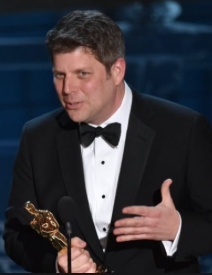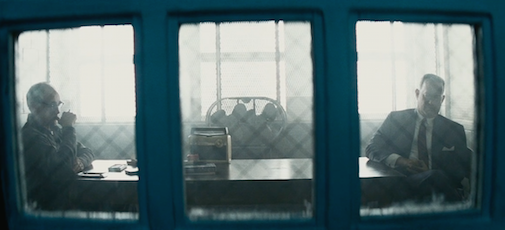 Adam Stockhausen won the Oscar on his first nomination for GRAND BUDAPEST HOTELEmmanuel Lubezki (who keeps winning prizes) isn't the only craft superstar repeating the Oscar rounds this year. Last year's winner for Production Design Adam Stockhausen (Grand Budapest Hotel), a 43 year old powerhouse who's amassed a very impressive resume in just a doesn't years, is back in the mix this season with the Cold War drama Bridge of Spies.
Adam Stockhausen won the Oscar on his first nomination for GRAND BUDAPEST HOTELEmmanuel Lubezki (who keeps winning prizes) isn't the only craft superstar repeating the Oscar rounds this year. Last year's winner for Production Design Adam Stockhausen (Grand Budapest Hotel), a 43 year old powerhouse who's amassed a very impressive resume in just a doesn't years, is back in the mix this season with the Cold War drama Bridge of Spies.
That Best Picture nominee is his first movie with Steven Spielberg but he's already worked with auteurs like Steve McQueen (12 Years a Slave) and Wes Anderson (Moonrise Kingdom) on terrific projects, too.
Here's our interview:
NATHANIEL: From Wes Anderson to Steven Spielberg! These auteurs seem very different. I imagine Wes Anderson making his own dioramas, and being like "Recreate this. Adam!". Whereas Spielberg, I don’t think of him in that 'this is what the set looks like' way at all!
ADAM STOCKHAUSEN: They have more similarities than you think. I don’t know if I want to get too deeply into what they do, because I’ll leave that for more esteemed people than myself, but I certainly see similarities. There are differences in the day to day: Wes pre plans shots and they’re carefully choreographed, Steven is slightly different in that the shots aren’t planned in advance, but the choreography is very similar.
ADAM STOCKHAUSEN: Shots are used to fulfill multiple purposes at the same time, much like a master shot that leads into something else that then spins and tells us an intimate story a second later. They both do that, they just go down different paths.
NATHANIEL: How do you even begin on something like Bridge of Spies. It's more realistic than your work with Anderson which is so mood and color based. I assume you have to approach it in a different way.
ADAM STOCKHAUSEN: In a slightly different way, although again, there’s more similarities than you might think. Grand Budapest Hotel, it wasn’t made up out of thin air. It was about a ton of research and then about a throwing a ton of details that we loved and assembling them into a collage, a new thing. On Bridge of Spies, it was very real events, but it was a similar process. So, you’re looking at a building of the Berlin Wall, that’s a well-documented event. We looked at documentary film of it, some from the British Pathe, we looked at thousands of photographs of the event. But it’s the same process of going, 'Oh my god, I’m overwhelmed, there’s a billion photographs, and a lot of it is noise, and how are we going to find the key ones that tell a story in there?' And then how are we going to put them on a wall, and hold on to them, and bring them forward, so we can feel them in the finished style, in the finished set, in the movie? That process is actually kind of similar, whether it’s truth or fiction.
 Rudolf Abel deciphering a secret message
Rudolf Abel deciphering a secret message
Let's talk about one of the most memorable sets in the movie, Rudolf Abel's work room, where he has all the funky equipment, and he’s painting and such. For something like that, you have the set decorator, you have the art director, and you have yourself. How do you do attack it from different angles?
It starts with research. There are the existing FBI photographs of Abel’s studio, where he painted. They weren’t perfect, we didn’t have every square inch of the place, but there were inspirational shots of his equipment, like he had run this antenna out through the window, and onto the roof, and he was receiving broadcasts. All of the paintings were in piles in the corner of the room. So we had some inspiration for what this might look like. We couldn’t use the original paintings so we made our own. We wanted them to feel inspired by the same vein as those original paintings. So we started making those, and we started scouting for a location to do this.
You’re in New York, right? It was upstairs from that building in Dumbo, that Abel actually came out of. Movies do funny things sometimes, and the schedule changed, so we couldn’t shoot in that location we loved. We stood there with Steven and said 'this place just feel right, this place just feels like this kind of attic-y sort of place, but also very New York, it just feels like those FBI photographs.' It had the white spear.
But it just didn’t work into the schedule and it would have cost a ton of money but we loved it so much that we decided to copy it. So we actually built the set and copied the details from this place. And then the set decorator, Rina D’Angelo, got involved and she started pulling all those pieces one by one by one and giving the space life.
When I saw that scene when they have all the evidence laid out on all the different tables later on in the film, I thought, whoever did the props – I assume there’s a prop person – or your team, that must have been a ton of work for that half a minute scene!
Oh, yeah yeah, it was kind of a combo project between Rina, and the set decorating team, and Sandy Hamilton, the prop master and her team, and it was a kind of a meeting of the minds there to get the best pieces for the layout for that moment.


What was the hardest thing on this film?
We actually went to a town in Western Poland to shoot the East Berlin wall building sequence. The hardest part was finding that and making that happen, the Poland section.
With the dilapidated rooms and such in the Berlin scenes, was that all locations, or did you have to build sets that appeared to be breaking down like that?
Some of each. We just talked about how Abel’s paint studio was a sate, the hotel room where he was arrested was a set, but the room where Frederic Pryor goes to pick up his thesis and try to get his girlfriend and her father, that’s a location. The prisons were predominantly location work, including one really remarkable one in Berlin, this former Stasi prison called Hohenschönhausen, which is a museum now. They don’t generally allow filming, but because this story related to real events, they very kindly and untraditionally opened their doors.
It’s really special to get to use the real places. The movie is a combination of real locations and sets. Hopefully, they blend together and you can’t really tell which is which.
It works. To be honest I’ve been kind of astonished with your range thus far.
Well, thank you, I appreciate that.
 BRIDGE OF SPIES (2015)
BRIDGE OF SPIES (2015) MOONRISE KINGDOM (2012)
MOONRISE KINGDOM (2012) 12 YEARS A SLAVE (2013)
12 YEARS A SLAVE (2013)
NATHANIEL: It was the switch from Moonrise Kingdom to 12 Years A Slave that did it for me. I was like, What, what? How? I know you worked in theater and you also worked with Mark Friedberg, who does beautiful work, while you were coming up in the movies. How much did you learn on your first set? How did you move up so quickly?
ADAM STOCKHAUSEN: There’s a few different answers to that question. The first thing was I started working in theater and opera as a set designer, for a significant amount of time before I started working in movies. When I kind of flipped over into movies, I had been designing for a number of years, and wasn't starting out at the first wrung on the latter.
Then, and more importantly, I just met the most extraordinary people who were tremendous influences on me, and bent over backwards to give me opportunities. For instance, you mentioned Mark Friedberg, who taught me an incredible amount about how to do this. And then other folks as well. Wes Craven gave me my first design job on My Soul to Take, which he didn’t have to do, and it wasn’t an easy thing to do, to take this guy who had only art directed three movies, and give him the design of this movie, which wasn’t a tiny little movie. We got along really well, and he trusted me, and he went to bat for me to make that happen. I’m sure he got a few phone calls going, 'What the hell? Who did he hire?' I’m very sure he got those phone calls. There were certain people along the way who helped me out and believed in me and I’m incredibly thankful for those people for making this all possible.
You’ve worked on musicals, really theatrical stuff, different time periods. What’s next for you? What would you really love to do?
Well, the next one is even different. I’m doing another one with Steven that’s called Ready Player One, and it’s sci-fi.
Ooh, sci-fi, you haven’t done that yet. Unless you wanna count everything Julie Taymor does as sci-fi.

Index of This Season's Interviews
More on Bridge of Spies
More on the Oscar Race
